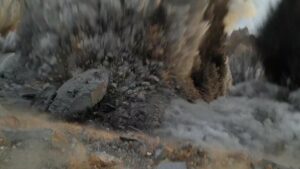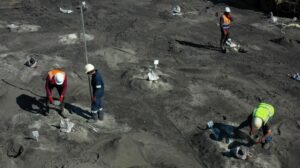
Velocity of Detonation (VoD) Explained
This article delves into the fundamental concept of Velocity of Detonation (VoD) and its profound significance in blasting activities within the mining and quarrying sector.
The article explores the concept of scaled depth of burial (SD) and its significance in mitigating environmental impacts associated with blasting activities in mining and quarrying operations. Blasting is commonly used to extract minerals and materials from the Earth’s crust, but it can lead to concerns such as ground vibrations, air overpressure, and flyrock. Understanding SD, which measures blast energy confinement, is crucial for managing these impacts effectively.
SD is defined as the ratio of stemming material to explosive within a space equivalent to 10 hole diameters. Higher values of SD indicate deeper burial depths, resulting in controlled energy and reduced surface activity. The calculation of SD involves parameters like top stemming, explosive density, explosive diameter, and length of 10 explosive diameters.
The importance of SD lies in compliance with regulatory standards, where mine operators can use it to analyze blast outcomes and ensure safety against flyrock and ground vibration. By optimizing blast design parameters using SD, mining operations can achieve desired production outcomes while minimizing environmental impacts.

To mitigate adverse effects, operators can adopt various measures such as blast design optimization, monitoring, and prediction systems, advanced blast management techniques, and the use of stemming devices like Varistem plugs. A case study demonstrates how Varistem plugs were employed in an open-cast coal mine to minimize flyrock and enhance energy retention during blasting.
In conclusion, considering SD is vital for reducing environmental impacts during blasting in mining and quarrying operations. By implementing appropriate mitigation measures, the industry can continue extracting resources while minimizing its ecological footprint.
Blasting activities are a common practice in mining and quarrying operations, facilitating the extraction of valuable minerals and materials from the Earth’s crust. However, these activities can generate significant environmental concerns, including ground vibrations, air overpressure, and the potential for flyrock. One crucial aspect of managing these impacts is understanding and implementing appropriate mitigation measures. The concept of scaled depth of burial plays a crucial role in evaluating and addressing the potential effects of blasting activities. This article will explore the concept of scaled depth of burial and its importance in minimizing environmental impacts.
Scaled depth of burial (SD) is an empirical measure of blast energy confinement and can be described as the ratio of the stemming material to the amount of explosive within a space equivalent to 10 x hole diameters (Tobin, 2013). The schematic below is a visual indicator of SD and evidently depicts how the ratio of stemming to explosives influence the measure of blast energy containment. Higher values of SD suggest deeper burial depths, which can result in an increase in controlled energy and minimal surface activity. By considering the scaled depth of burial during blasting design and execution, it is possible to mitigate the potential environmental impacts associated with ground vibrations, air overpressure and flyrock.


Using Equation [2] and the following input data:

According to the diagram and the SD calculated, the measure of energy containment of this bast would be classed as controlled energy (SD 0.92-1.40) which would generally result in good fragmentation and heave with acceptable airblast and vibration. For an easy-to-use SD calculator, you can use our built-in calculator on our website.
Many jurisdictions have specific regulations in place to ensure safety against the risk of flyrock and to limit ground vibration and noise levels generated by blasting activities. By analysing the scaled depth of burial and comparing the predicted blast outcomes to regulatory limits, mine operators can ensure compliance and prevent potential damage claims or legal issues. This is especially critical in sensitive environments, such as residential areas and critical infrastructure like powerlines.
Flyrock is also of concern when basting in close proximity to infrastructure or people and preventative measures should be taken to limit the amount and range of flyrock when blasting. This is also done with the assistance of the scaled depth of burial as it predicts the amount of surface activity expected within the ranges of stemming to explosive ratios. An increase in stemming will lead to increased confinement (a higher SD) thus limiting the transference of energy into the air and increased energy distribution into the rock mass, which in turn leads to less stemming ejection and less flyrock.
The knowledge of scaled depth of burial can aid in optimising blast design parameters. By adjusting the stemming, hole diameter, explosive charge mass, burden and spacing distance, mining and quarrying operations can achieve the desired production outcomes while minimizing potential environmental impacts.
To mitigate the potential adverse effects associated with blasting activities, mine operators can adopt several measures:
By considering the scaled depth of burial, engineers can fine-tune the blast design to ensure that the ground vibration levels, airblast, noise and flyock remain within acceptable limits. This may involve adjusting the explosive charge mass, burden and spacing or stemming hight. More specialist techniques such as airdecking, stab holes or stem charges could also be used to effectively break the top coarse layer in a more controlled manner.
Implementing a robust monitoring and prediction system allows for real-time assessment of the effects of blasting activities. This enables immediate action if predetermined thresholds are exceeded, ensuring prompt mitigation measures are implemented.
The adoption of advanced blast management techniques, such as electronic initiation systems and seismic sensors, can help in achieving precise control over the blasting process. These technologies allow for improved accuracy, reduced ground vibrations, less airblast and less flyrock with overall enhanced safety. Another mitigation strategy is the use of stemming devices such as Varistem plugs, Tulip plugs, gas bags etc. to improve the stemming performance and enhance energy retention which in turn yields more controlled effects during blasting.
This case study serves as an example of blast management through the use of Varistem stemming plugs. The mine relating to this case study is an open cast coal mine in the Mpumalanga province of South Africa and is situated close to neighbouring farms, of which one is within the 500m blasting radius. The challenge for the blasting crew was to ensure that flyrock is minimised and not thrown onto the closely situated farm whilst also obtaining relatively good fragmentation. Varistem plugs were used to assist in obtaining better energy retention whilst also minimizing flyrock noise and airblast. Based on the SD values calculated for the blast and accompanying theory, violent flyrock was expected from the majority of the holes to be blasted (see figure below).

The post-blast analysis indicated that the flyrock was contained to within 100m from the blast location and that the ejection noted was less violent than anticipated (see following figures).




Since the Varistem plugs were the only additional mitigating factor employed on the design, the difference in results (from expected to reality) can be attributed to the assistance of the Varistem plugs. However, the measure of impact of the Varistem plugs can only be known when more trial blasts are done on similar blocks (geology and blast design) with and without Varistem plugs, to evaluate the difference in performance and the level of impact that the Varistem plugs yield.
The scaled depth of burial is a crucial parameter that plays a significant role in minimising environmental impacts associated with blasting activities at mines and quarries. By considering this concept during blast design and execution, mine operators can mitigate ground vibrations, reduce air overpressure and flyrock and ensure compliance with regulatory standards. The implementation of appropriate mitigation measures, such as blast design optimisation, improved energy retention and reduction and blowouts by using stemming devices and advanced monitoring techniques, is vital in safeguarding the environment and nearby structures. By adopting these practices, the mining and quarrying industry can continue to extract valuable resources while minimizing their ecological footprint.
Ash, R.L., 1993. Blast vibration control. Prentice Hall.
BAI, 2008. Resources/ Scaled depth of Burial Diagram. [Online]. Available at: chrome-extension://efaidnbmnnnibpcajpcglclefindmkaj/https://ergindustrial.com/wp-content/uploads/2022/08/Scaled-Depth-of-Burial.pdf [Accessed 1 Aug 2023].
ERG Industrial, 2023. Resources/Calculators/Scaled Depth of Burial. [Online]. Available at: https://ergindustrial.com/scaled-depth-of-burial/ [Accessed 7 July 2023]
Langefors, U., and Kihlström, B., 1978. The Modern Technique of Rock Blasting. Wiley Interscience.
Ranganathan, S., 2010. Scaled distance concept and its application to blasting. ISEE Blasters’ Handbook, 18th Edition, Chapter 20, International Society of Explosives Engineers.
Tobin, G., 2013. The Importance of Energy Confinement to the Blast Outcome & Justification for use of Stemming Plugs in Over Burden Removal, Australia: ORESOME Products.

This article delves into the fundamental concept of Velocity of Detonation (VoD) and its profound significance in blasting activities within the mining and quarrying sector.

This article delves into the causes, effects, and mitigation measures related to flyrock incidents. It emphasises the importance of understanding mechanisms like face bursting, cratering,

The purpose of the Varistem® stemming plug trial conducted at Coal Mine X was to reduce flyrock, noise, and airblast by retaining blast energy. The
Managing Director
Eugene Preis | eugene@ergindustrial.com
Operations Director
Reinhardt Steyn | reinhardt@ergindustrial.com
Administrative
Annette Schreiber |annette@ergindustrial.com
+27 60 805 6550
General Enquiries
info@ergindustrial.com | +27 60 805 6550